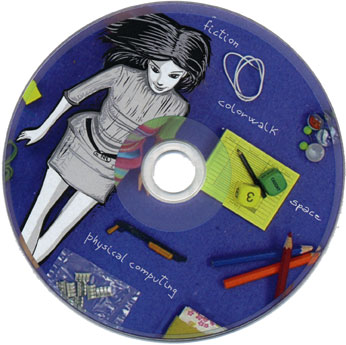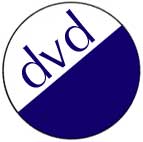

Interaction Design Primer
The book: the complete Interaction Design Primer is included as a PDF, in high and low resolution for screen viewing or printing.
Processing: in the Processing directory you will find installers for the Processing programming environment for Mac OS, Linux and Windows. For the latest version of Processing, be sure to check www.processing.org – it is Open Source software! Programs included in the book have been developed with processing0069: most of them also work with more recent versions of the software.
The videos: a selection of short videos and loops about interaction design activities we have worked on in recent years. All the videos, unless stated otherwise, have been directed by Simone Muscolino. More detailed video and project credits are included on the disc itself.
Interaction Design Primer
indice PDF index
1.0 | 010 |
The world of self produced books
Fold, glue, staple, sew, compute, sort, draw, shape your way into design. The practice, theory and materials of taking notes on people, places and things.
1.1 | 012 |
How to make a notebook
Why it is good to have one. The fascinating realm of physical materials. Perception and proportion. Form follows function. Or maybe function follows form. Golden ratio. Different binding methods. Leonardo da Vinci.
1.1 | 024 |
Appendix | Introduction
to Processing
Does a designer need to know programming? Processing: a Java-based language that designers can use for simple interactive sketching. Your first Processing programs, integers, reals, division pitfalls and going for gold.
1.2 | 034 |
How to make an address book
We live in a networked world. Address book or toolbox? How to Make Friends in Life vs The Art of War. Is the world really small? Edward Tufte and visualization of information. Maps, time, French philosophers and pop culture.
1.2 | 044 |
Appendix | Crunching strings for a better address book
How to produce a printed address book from your email address list. Mixing something as abstract as computer programming with the physicality of paper. Iterative refinement and how to not fall off the end of the array.How
1.3 | 056 |
How to make a booklet
Design as narration. How to tell our stories in the best possible way. Keeping memories. Lines of activities. The difficult task of choosing the right computer application. Luis Buñuel.
Radioactive zones and eating elephants.
1.3 | 066 |
Appendix | Your first digital layout
Columns, gutters, how to go crazy on a grid and the incredible power of computer applications. Douglas Engelbart and how Xerox Park gave us the mouse, the Net and most of what we take for granted. Making a booklet: basic things to know.
2.0 | 076 |
The diary, myself, the world. Reorganized notes about your days. Reorganized living creatures. Reshaped spaces and brains. Retold stories. The universe reconsidered.
2.1 | 078 |
How to track your life
The diary. The world around
you and the world inside of you. Recording maniacally what you see. You cannot escape yourself. The detail reveals the structure. Filters and frames. A trip to the Bauhaus, allegro con Bockwurst.
2.1 | 090 |
Appendix | How to sketch
Ten simple tricks for learning how to do it. Try, retry, and try again. Why the world changes if you know how to sketch. Drawing with the left part of your brain. Negative space, angles and shadows. Ben Shahn.
2.2 | 100 |
Learning from bananas. How DNA entered the world of design. How to extract the DNA of a banana. Why this is important for the things we do. Living with a pig (not metaphorically). Critical design. An interview with Elio Caccavale. Ballard, silk goats, Temple Grandin, Oliver Sacks, James Ballard.
2.2 | 110 |
Appendix | Form follows fiction
Design via scenario techniques. Science fiction and storytelling. For a British approach to fictional design: from George Orwell to Tony Dunne and Fiona Raby.
2.3 | 120 |
How to make a cellular automaton
On the road. Simple rules that can create great complexity. Unpredictability is not random-ness. The paradoxical lesson of Brian Eno. Does chaos belong in Life? Stephen Wolfram. The temptation of literality in design. Cargo cults.
2.3 | 136 |
Appendix | Build your own cellular universe
What is state? How much state do you need? Pseudocode for abstraction in software. Repre-senting time and boundaries. Bending a rectangle into a torus for a limitless finite space. Inter-activity via mouseDragged.
3.0 | 146 |
Games. Computation... electronic!
Wooden computers, thinking of computers, computers that think of applied dadaism through colourful resistors and energetic little Turing machines.
3.1 | 148 |
How to make a matchbox computer
Computation, Eliza, apparently intelligent behavior arising from dumb rules. Games. Martin Gardner. Fun. Collecting matchboxes and M&M’s. Why coloured candy is so important in our life. Is this intelligent? Is this a computer?
3.1 | 160 |
Appendix | Polygen, better than magnetic poetry
Getting and installing Polygen. Well-founded in linguistics, great fun to use. Producing our own designerly propaganda through applied dadaism. A reflection on human communication. Declarative and imperative programming.
3.2 | 168 |
How to make a Turing machine
Universality, recursion. Computation does not require computers. Drawings inside drawings. Escher and the power of self-reflection.
3.2 | 180 |
Appendix | A Turing machine simulator
Why don’t we use our computer to make a digital and programmed version of the universal machine? Pseudo-code, representations, methodology and discipline. Visualizing infinitely long tapes on finite rectangular screens.
3.3 | 188 |
Going electronic
The great pleasure of hacking. Putting the yellow wire where it belongs. Instant Soup, a tool for prototyping. When the software become hardware, or the intricacies of intellectual property. The infrared world. Wiring and Arduino.
3.3 | 200 |
Appendix | First steps into physical computing
The Basic Stamp, the Stamp Basic. Turning an LED on. Resistors and capacitors. Actions in the physical world that influence events inside a computer: building the link. Garbage in, garbage out. Dr. Lissajous and his figures.
4.0 | 212 |
Tying it all together
Color made complex and very difficult. Methods of teaching and learning. A bridge to the future. Post hoc rationales are always believable.
4.1 | 214 |
How to make a colourwalk
Perception mediated through
culture. William Burroughs. Strenghtening your observational skills. Collecting skies. How many colours can you name? What is colour? The visual spectrum. Flanerie, drift. Observe, analyze, document.
4.1 | 226 |
Appendix | The realm of colours
Some little theory. We live in a world of colours. Black and white, addition, subtraction. What is a colour scheme? Why it is useful to think in terms of color schemes. Itten and the heroes of modern design. Rods, cones and red cranes.
4.2 | 238 |
How to teach, how to learn
Learning by doing it over. Skill acquisition and social competence. Why telling a good story is the basis of all good design.
4.2 | 248 |
Appendix | Learning by doing. But doing what?
CICCIO? Inflatables are not an original solution, but they are a good solution. Documenting a process. Life without objects. Modularity. A special kind of simplicity that works for smart people only. The destruction of the object.
4.3 | 254 |
People, places, things.
The curious index of this book. It is an index, but it is organized in the way we like best. The whole book cut up into people, places, things. It is not Wikipedia, it is not the Britannica, it slices, it dices, it spouts large amounts of trivia. Enjoy.
4.3 | 278 |
Appendix | Thinking about vol. 2
In which we drop many names, establish a connection between writing a book and dreaming, reveal our techniques and lay out our grand plans for the next volume.
° Cluster event
° This is today. The invasion of interactive bodysnatchers.
° This is today. The macking of.
° Ciccio goes to China.
° Dead in Venice. A story must tell itself
° Tavofono
° Telpafono
° Green house effect
° Strangely familiar. Unusual Objects for everyday life

